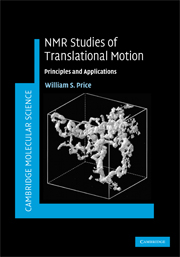Book contents
- Frontmatter
- Contents
- Preface
- Acknowledgements
- Abbreviations
- 1 Diffusion and its measurement
- 2 Theory of NMR diffusion and flow measurements
- 3 PGSE measurements in simple porous systems
- 4 PGSE measurements in complex and exchanging systems
- 5 PGSE hardware
- 6 Setup and analysis of PGSE experiments
- 7 PGSE hardware and sample problems
- 8 Specialised PGSE and related techniques
- 9 NMR imaging studies of translational motion
- 10 B1 gradient methods
- 11 Applications
- Appendix
- Index
- References
9 - NMR imaging studies of translational motion
Published online by Cambridge University Press: 06 August 2010
- Frontmatter
- Contents
- Preface
- Acknowledgements
- Abbreviations
- 1 Diffusion and its measurement
- 2 Theory of NMR diffusion and flow measurements
- 3 PGSE measurements in simple porous systems
- 4 PGSE measurements in complex and exchanging systems
- 5 PGSE hardware
- 6 Setup and analysis of PGSE experiments
- 7 PGSE hardware and sample problems
- 8 Specialised PGSE and related techniques
- 9 NMR imaging studies of translational motion
- 10 B1 gradient methods
- 11 Applications
- Appendix
- Index
- References
Summary
Introduction
Most simplistically, mutual diffusion can be probed by imaging diffusion profiles (e.g., the ingress of a solvent into a material). However, the integration of MRI techniques with the gradient-based measurements of translational motion that we have discussed in previous chapters allows for potentially more information to be obtained – especially from spatially inhomogeneous samples. It also provides additional techniques for measuring such motions. Diffusion is extremely important in MRI, and, amongst other effects, at very high resolutions it determines the ultimate resolution limit when the distance moved by a molecule is comparable to voxel dimensions. Further, since motion is more restricted near a boundary, the spins near the boundary are less dephased (attenuated) during the application of imaging gradients in high resolution imaging, consequently a stronger signal is obtained near the boundary and this has become known as diffusive edge enhancement. Relatedly, since the length scales that can be probed with NMR diffusion measurements encompass those that restrict diffusion in cellular systems, the combination of PGSE with imaging techniques can result in MRI contrasts. Whilst there can be diffusion anisotropy at the microscopic level (e.g., diffusion in a biological cell), the MRI sampling is coarse and thus if there is too much inhomogeneity of the ordering of the microscopic anisotropic systems, the information obtained from the voxel will appear isotropic.
- Type
- Chapter
- Information
- NMR Studies of Translational MotionPrinciples and Applications, pp. 296 - 307Publisher: Cambridge University PressPrint publication year: 2009
References
- 1
- Cited by



